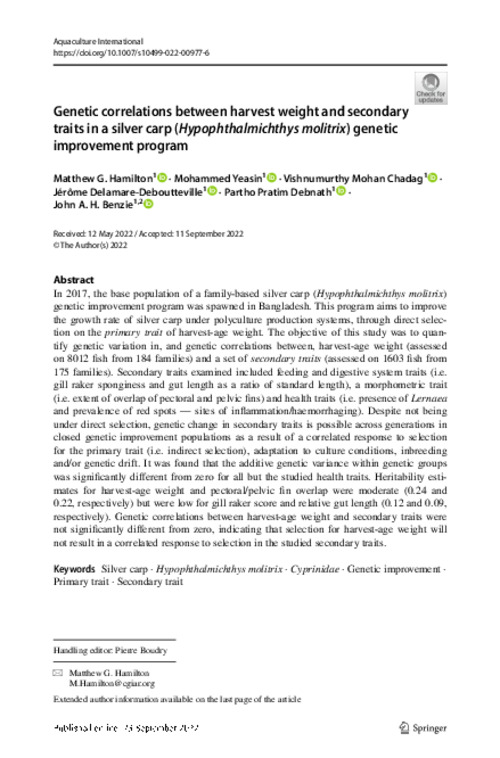Genetic correlations between harvest weight and secondary traits in a silver carp (Hypophthalmichthys molitrix) genetic improvement program

In 2017, the base population of a family-based silver carp (Hypophthalmichthys molitrix) genetic improvement program was spawned in Bangladesh. This program aims to improve the growth rate of silver carp under polyculture production systems, through direct selection on the primary trait of harvest-age weight. The objective of this study was to quantify genetic variation in, and genetic correlations between, harvest-age weight (assessed on 8012 fish from 184 families) and a set of secondary traits (assessed on 1603 fish from 175 families). Secondary traits examined included feeding and digestive system traits (i.e. gill raker sponginess and gut length as a ratio of standard length), a morphometric trait (i.e. extent of overlap of pectoral and pelvic fins) and health traits (i.e. presence of Lernaea and prevalence of red spots — sites of inflammation/haemorrhaging). Despite not being under direct selection, genetic change in secondary traits is possible across generations in closed genetic improvement populations as a result of a correlated response to selection for the primary trait (i.e. indirect selection), adaptation to culture conditions, inbreeding and/or genetic drift. It was found that the additive genetic variance within genetic groups was significantly different from zero for all but the studied health traits. Heritability estimates for harvest-age weight and pectoral/pelvic fin overlap were moderate (0.24 and 0.22, respectively) but were low for gill raker score and relative gut length (0.12 and 0.09, respectively). Genetic correlations between harvest-age weight and secondary traits were not significantly different from zero, indicating that selection for harvest-age weight will not result in a correlated response to selection in the studied secondary traits.
Permalink
Date Available
Type
Countries
ISSN
0967-6120,1573-143X
Copyright
CC-BY-4.0
Research Themes
Language